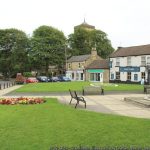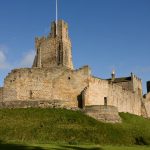Ever wondered if Whickham (the one near Newcastle) is worth a visit? We Say Yes and here are some the reasons to stop by.
Whickham lies within the Newcastle borough of Gateshead. About 17,000 people call this town their home. It is the perfect commuter area, close enough to the city to travel to, and easy enough to stumble home in a taxi if you have to. Whickham is famous for two things: farms and mining. Like many northern towns, it lies on the Tyne & Wear coal seam which led it to great success and growth during the industrial period.
Let’s go through the history of the town and move on to the best things to see and do there. By the end of this article, you ought to be a Whickham expert. Remember: with great knowledge comes great responsibility.
The Early History of Whickham
Back before the beginning of recorded history, the area close to the Tyne was under the control of the Brigantes tribe. This tribe owned huge portions of the north of England. Their base of power was in Yorkshire, but they also owned much of the Kingdom of Northumberland before it was ever a Kingdom. They didn’t quite reach the northern border though. That prize went to the poor Votadini tribe which was under constant attacks from the savages up north. Who, for the record, did not have blue faces.
Before even the Brigantes roamed the land here, there is evidence of both Bronze and Iron Age residents.
The Romans came, of course. We know this whole area was full of them because of Wallsend. They came here, conquered what they could, and then built a wall to keep out what they couldn’t control. To be fair, they did well to get this far north. There was a gigantic Roman Fort at South Shields which is now in ruins. They named it Arbeia. A little closer to home, the Romans settled a trapezoid-shaped Roman Fort which archaeologists only discovered 50 years ago. Even though the discovery is reasonably recent, the scientists have known about it through meticulous Roman records and looked for it for nearly 200 years before they found it in a field just south of town. This second, closer fort to Whickham is called Washingwells Roman Fort. The fort lies on a farm that overlooks the River Tyne. There is not much to see out there so it’s not worth the trip. At least we know about it now, though. That will stop us from accidentally building a motorway over the top of it. The Roman fort predates the wall and was likely a camping area for troops marching north.
Whickham comes from the Anglo-Saxon and means “the Estate with the Quickest Hedge.” We have no idea what that means. Perhaps in the olden day’s hedges used to move and we had an epic war to tame them that nobody else has mentioned before.
Something else we didn’t find out until right now is that the north had its own version of the Domesday Book, except this one was compiled on behalf of the Bishop of Durham. The book was called the Boldon Book and Whickham was definitely in it.
Whickham in the Boldon Book
We couldn’t find an online copy of this so we used the Whickham History page as our primary source. They say the Boldon Book record Whickham as “Quykham”, which makes more sense about the quick hedges. There were 35 tenants on the land, which belonged to the bishop, and each tenant paid 16d rent. There were services they had to perform as part of their tenancy which make you appreciate the modern Fitness for Habitation and Landlord/Tenant Acts. For example, the tenants had to carry the bishop’s bags when he travelled between Durham and Bedlington. They also had to either serve in his fishery on the Tyne, or give him a hen, 10 eggs, and 9 shillings in cornage tax each year. Those are high demands on lowly tenants. You’d be better taking your chances north of the border with those crazy Scots.
The Medieval Period
Local manor Hollinside Manor House dates to the 13th century. The first plans for the building had only two rooms – a hall for receiving and a room for sleeping. The building had two storeys and walls which were almost a metre thick. It was the creation of the Hollinside family circa 1300. In 1318 the manor exchanged hands with William Bointon taking ownership. There was a mill on the property, mentioned in 1318. The hall later belonged to descendants of a Newcastle Mayor, and it remained in the Harding family from the late 1300s all the way up to the 1730s. At that time it fell into foreclosure and became part of the Gibside Estate.
By 1356, the bishop was involved in the coal trade in the town. Once the surface coal was done with they started to dig down. The mine became a deep pit with miners’ deaths becoming regular as early as the 14th century. Many merchants and landlords flocked to the area to capitalise on the coal rush, while local men’s deaths were recorded in the parish register as ‘killed in the pit’. In the 1590s Whickham exported 40,000 tonnes of coal. You have to understand the scale of this. There was no building equipment and blasting equipment came later. These guys were down in the dark and the dust clawing at the earth with pickaxes and hauling it out by hand. There were no safety regulations and people died every single day. 40,000 tonnes is an incredible volume to shift by hand. Most of the other towns in the area didn’t start mining coal until at least the 1600s. Whickham was already rocking a full-blown trade by then. They mined coal here right up until the 1960s and only stopped because other power sources replaced it. If they hadn’t, Whickham would still be slaving away in the pits.
Fun Facts and Trivia About Whickham
Every town that we review has secrets to share. To get to the bottom of what the local gossip is, arm yourself with these fun facts before you go:
- The oldest building in town is St Mary’s Church. This is a 12th-century building which exists on the oldest street – the current main street, which is of medieval origin.
- There are many large country houses dotted throughout the countryside around here. Most were built by coal mine owners, such as Dunston Hill House. The stately home at Dunston has since gained a new life as apartments. It’s beautiful and lovely if you want to live in a listed building.
- Whickham began as a small agricultural community gathered around a town green. The green was likely used for grazing communal herds within the safety of the town.
- Whickham was built on a large hill so that it overlooks the River Tyne and loads of tributaries.
- There is a Roman fort to the south of it. In fact, Romans were prevalent throughout this area as they hid behind their big wall. As of yet, the fort is not excavated.
So far that’s not a lot of gossip for such a large town. You can follow us on Facebook or register to join the forum to add to it.
Mining in Whickham
Whickham has a long history with the mining industry. In the 1300s The Bishop Bury granted a 12-year license to the manors of Whickham and Gateshead to create mines. They immediately pulled up the surface coal. In 1356 the bishop appointed an overseer to be the keeper and vendor of his coal. In 1550 something mining rights were leased to John and Stephen Sotheran. In the 1570s, they went to Bartram Anderson – but all the while the land was being worked. Part of the old pits now lies in the rewilding areas of town.
In 1582 the Queen stole the mining rights from the church for ninety years, but she was the queen, so nobody complained too loudly. She passed those rights to the Earl of Leicester and later it fell into the hands of the Alderman. They sold those rights to the corporation of Newcastle which held it until its expiration in 1681… and everyone made lots of money except the guys shunting the coal, who made barely enough to keep clothes on their backs and all died with black lungs.
The mines reverted back to the bishop and he presumably sold them again. The Grand Allies eventually came into possession of the mining rights. Which didn’t matter one bit because the mines ended up in the hands of one family anyway. The Bowes controlled the mining in the area after one of them married a Gibside. They owned the wagonways and brought coal to the masses through dastardly ways until the mines shut finally in the 60s.
The Industrial Period in the North
Newcastle University records a wonderful article in the Historical Register of Remarkable Events. This article is from the first of August in 1834, and it remarks on the existence of a new coach run, which ran between Gateshead and Stanhope, passing through Whickham enroute. In the 1850s records say the town was a large, respectable village. To this day, you will still hear people say that Whickham, with its 16k+ and counting residents, is a bleedin’ big village.
Front Street, Rectory Lane, and Church Chare are all sport stone houses built circa 1700. The Church of St Mary, originally dating to the 1200s or perhaps earlier, went through upgrades in 1860-something under the skilful hand of one Anthony Salvin.
On School Lane, you will find Park Cottage. This is a former coach house from back in the days when horses and carts were the modern way to travel. These old coach houses are all over the UK. You can spot them because they have outlined archways in the centre, filled in with bricks. These archways were wide enough for the coaches and carriages to pass through the building. They would come inside and allow the passengers to disembark out of the rain. The GP’s practice on Rectory Lane also dates to 1713.
You will also find the windmill tower from 1720 in Chase Park. The windmill made flour for the town for over 100 years. In 2017 archaeologists examined the neighbouring land and found evidence of early farming activity. This could be the mill mentioned in the estate records compiled for the Boldon Book.
Modern Day Whickham
Modern-day Wickham is a far cry from the mining fields of old. It is a popular area to raise your family in, particularly if your job is in Newcastle and pays well. It’s a suburban, middle-class area with lots of leafy parks and plenty of interesting history. The old sandstone buildings make the town aesthetically pleasing, while the old village also has lots to see and do for all the family. Would we move here? In a heartbeat. If only because we have mining in our blood, too.
Famous People from Whickham
There isn’t a single town in the UK that doesn’t have at least one famous person from it. OK, so some only have one, but one is better than none. The UK is a hub of celebrity activity, didn’t you know? And they may well be hanging out in a bar in Whickham. Here are the faces you ought to look out for while you are in town:
- Mike Neville was born in Willington Quay but moved to Whickham in 1962. He would later work as a news presenter and become a well-known tv personality.
- Paul Gascoigne moved to the town when he was 11. He studied in the local school and learned to develop his football skills in these very streets.
- Former English footballer Peter Walters made 83 appearances in Bedford, his fourth club.
- There was also Joe Laidlaw who had an extensive football career. He played with six clubs during his time.
- William Tweddell was a famous amateur golfer who won the league in 1927.
OK, so you are unlikely to meet most of them in the frozen section over defrosting ice cream tubs, but you wouldn’t want to anyway, since most of them are dead. You are never too dead to be famous, though. Ask that bloke that cut off his ear. Or Shakespeare.
The Best Attractions in Whickham
What would the point of visiting be if you didn’t have anything to see? Lucky for you that you have a guide here that knows their way around Whickham. Here are the sights you ought to get in while you are here.
Historical sites
Although it has long fallen to ruins, you can go and visit Hollinside Manor. This building has been derelict since the late 18th century, so there is only a skeleton now. However, it is a beautiful walk and a fantastic hidden gem. You can kill two stones with one bird here because it is situated inside the beautiful Derwent Walk Country Park.
Local Landmarks
The Gibside Estate is both a local landmark and a historical location. This is a Georgian-style building with exceptional landscaping, with plenty of walks for you to choose from. Enjoy the gardens in summer or visit the house itself at Christmas time. Now owned by the National Trust, Gibside Hall was the project of Willian Blakiston in 1620. The landscaping was the project of Sir George Bowes, a founding member of the Grand Allies of Durham Coal Miners.
Outdoor attractions
Derwent Walk Country Park doesn’t just have the ruins of a 12th-century manor house. It also has wetlands, meadows, woodland, a river, and even a few rewilded areas. Rewilding is the process of introducing new habitats to the old industrial areas of land. Derwent walk covers part of an old industrial estate that has seen just such love. Managed by Gateshead council, the area is the size of 146 football pitches.
There is a park in Whickham which combines local landmarks with historical sites and outdoor attractions. Take a wander through Chase Park in town and you should see the sturdy tower of an old 1720’s windmill. The park also has an area for tennis, bowling, skateboarding, and a play area. Basically, it has everything you need for the full family to show up in the am and play till dinner.
Culture and Recreation
Take a walk through the local community garden. The volunteers that come together from the community to create this garden are the heart and soul of the town. They have won several awards for their skills and presentations. Visit in spring or summer to wander through the flower beds or have a chill on one of the benches. It’s a refreshing place to be. There is also a small café which should satisfy your need for tea and cake.
Sports and Teams
The local football team are Whickham FC. Whickham play in the FA cup but the team wasn’t founded until 1944. In the grand scheme of the football world, that’s kind of late. They originally named themselves the Axwell Colliery Welfare team. They played in the Derwent Valley League and later in the Northern Combination. In 1974 they joined the Wearside League and haven’t looked back since. You can find them in the Glebe Sports Ground on Rectory Lane.
As for the nation’s favourite, you can find Whickham Golf Club just outside of town. This is an old club, founded in 1911. It moved to Hollinside Park in 1938. The clubhouse is fully licensed so if you do win your game be prepared to pay for the loser’s lunch.
Shopping and Retail
You have all the shops you need to satisfy your wants on a day-to-day basis. If you want real shop-till-you-drop stuff, head into Newcastle proper and have a hunt. You will find a card and gift shop, plenty of grocery stores and a Tesco Express, there is a shoe shop, a swimwear shop, and a dozen other stores you never knew you needed till you saw them. Go nuts.
Eating and Drinking in Whickham
The nearest fine dining restaurant is the Gibside Hotel in Gateshead. Not only do they have comfortable rooms but they have beautiful food and drink, too. If you want great banter from the locals, good food and a better pint, head to the Bay Horse. It’s a true favourite with the natives. The One Eyed Stag and the Coachman are also nightlife hotspots if you want somewhere to party.
Other Notable Attractions
In this section, we like to detail the things you might want to investigate if you are in this area of the country for a while. A fortnight’s stay in Newcastle warrants visits to some of these other locations:
- Visit the nearby new town of Killingworth
- Go and see the old shipyards at Jarrow
- Visit Houghton-le-Spring for the festival
- Go to Hebburn to the east
- Or learn about the Romans in Wallsend to the north
- Visit George Washington’s ancestral land
And if all that leaves you wanting more, you can browse the rest of our Tyne & Wear travel guides here.
How to get to Whickham
We couldn’t send you off on a journey to Whickham without explaining how you can get there. Here are our semi-tolerable directions to Whickham to help you on your way.
By Road
Whickham is within the boundaries of the Newcastle upon Tyne suburbs. Follow the A1 away from the town centre.
By Rail
You can get the metro to Gateshead, which is about four miles from Whickham. Seek the bus instead.
By Air
Newcastle International is your nearest UK airport.
By Sea
The nearest port is likely Tynemouth.
Five Minutes Spare
If you enjoyed this article and you demand more, then you are in luck. We already have hundreds of travel guides to British towns and cities for all the new travellers to the UK. Find your perfect staycation or holiday destination on our website or follow us on Facebook to encourage us to keep working.





